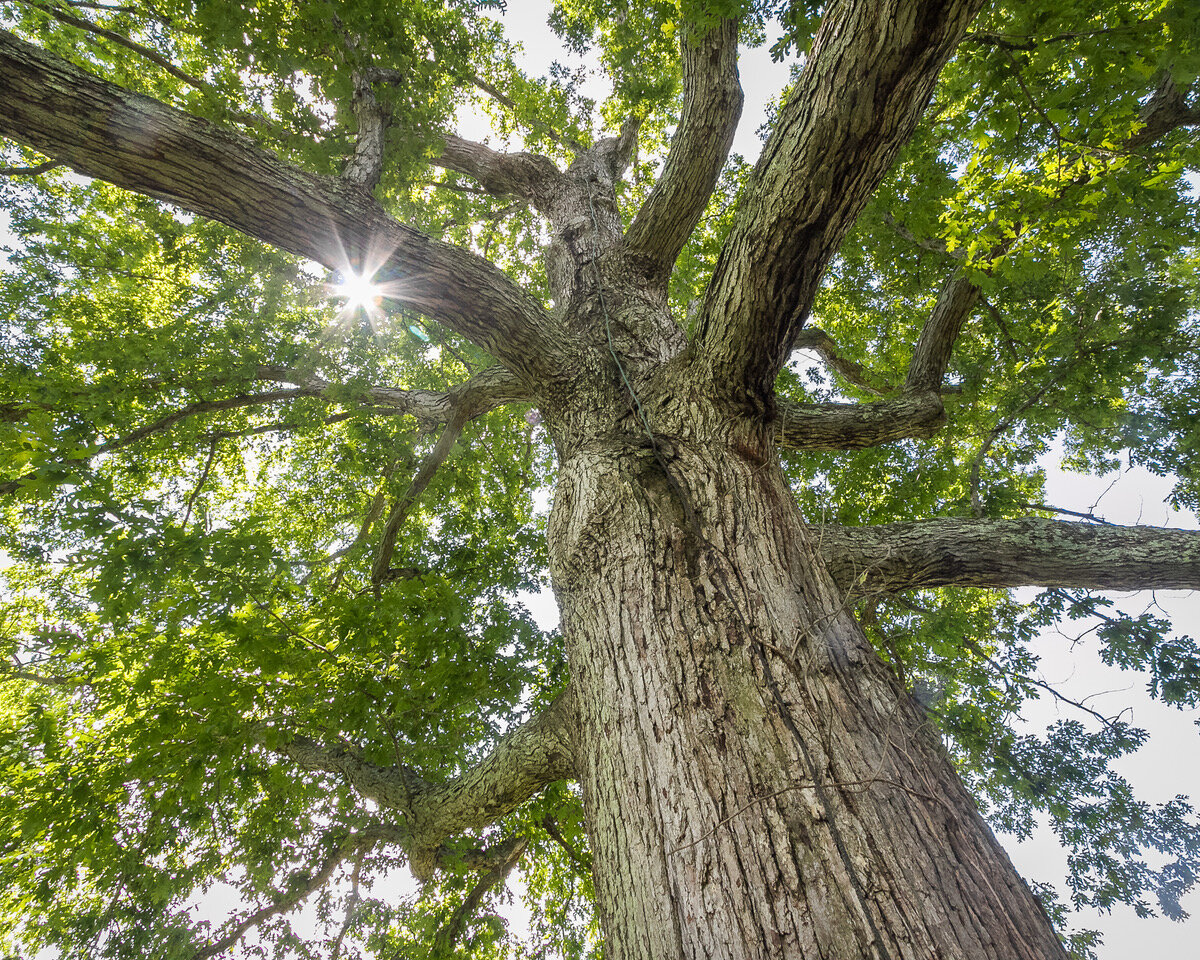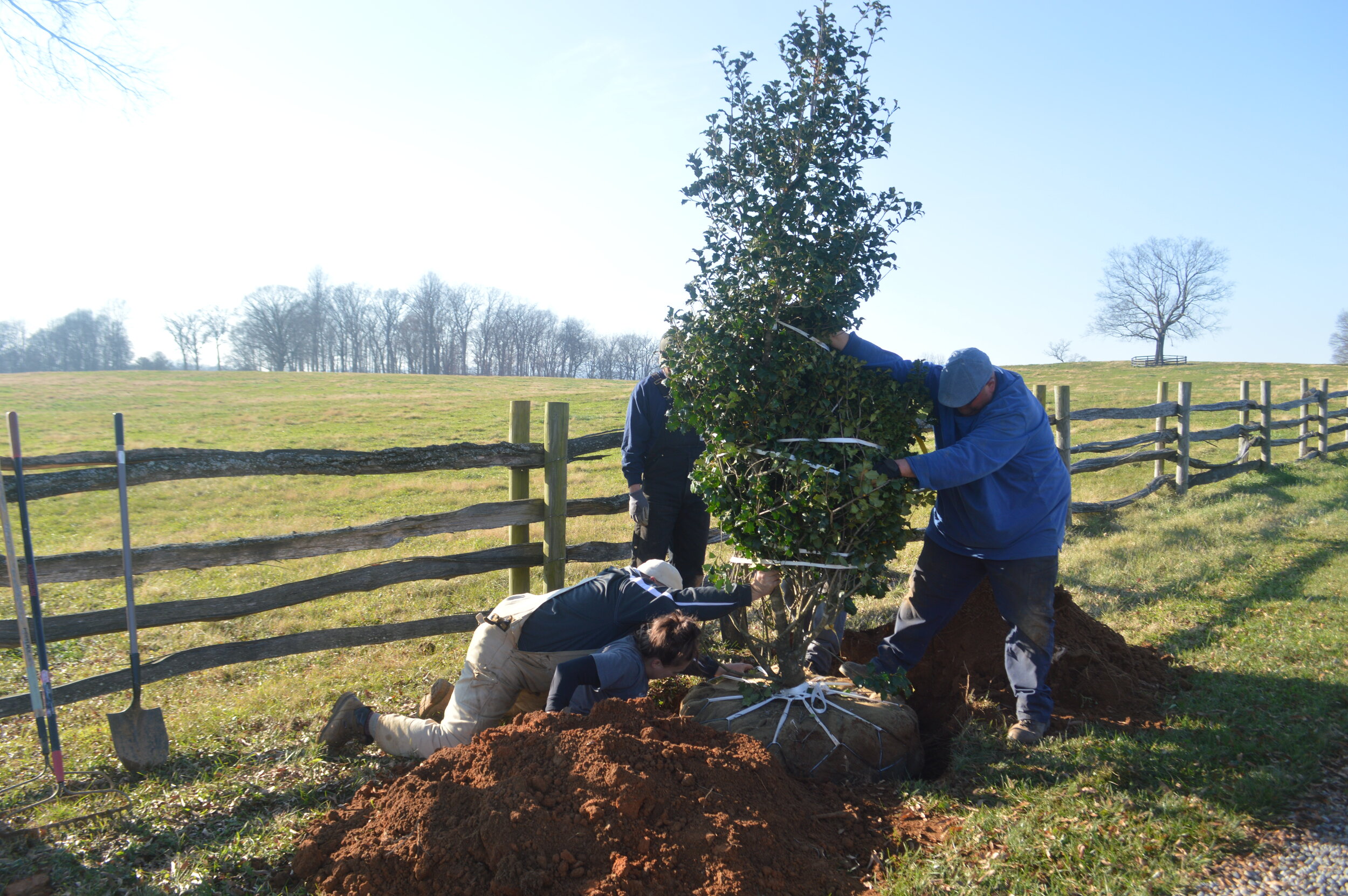Planting for the Birds
Emily Ellis
Many plant and animal species have incredibly close relationships, depending on each other for food, shelter, reproduction, and more. Often, one can’t survive and thrive without the other, and this is especially evident when it comes to native birds. Some of our most beautiful and vulnerable species, the populations of many birds around the country are in decline due to loss of habitat.
“We’ve lost half of our birds in our lifetime, and a lot of that’s about habitat,” said Tom Wood, a professor of conservation studies at George Mason University, during a recent birding trip to Oak Spring. “We don’t know all the problems, but the close interaction between animals and their habitat is certainly an important part of it.”
Planting trees, grasses, and flowers that support diverse insect populations, produce ample fruit and nuts, and provide shelter and nesting materials at different times of the year is a great way to support local bird populations. If you’re in the Northern Virginia area, scroll down to read about several native plants that birds adore.
Oaks
The Oak Spring Garden Foundation’s namesake tree is a haven for a wide variety of native birds. According to Doug Tallamy’s book Bringing Nature Home, they are the “quintessential wildlife plants”, supporting more species of Lepidoptera [butterflies and moths] than any other plant genus. Among the largest and longest-lived trees in our region, oaks provide a sort of town square for a variety of animals. For birds, the trees offer up a hefty buffet of insects, fruit and nuts, and ample space to nest and take shelter both in the branches and in the cavities the trees develop as they age.
They’ll get big as the years go by - Oak Spring’s largest white oak, for example, is over 60 inches in diameter at around 300 years old - but if you have the space on your property to plant one, the local wildlife will thank you.
Woodpecker evidence on a long-dead white oak at Oak Spring
A wide variety of native birds - especially insectivorous species - are fond of oaks, but some birds to keep an eye out for if you have these trees on your land are woodpeckers, who devour the larvae and insects that live beneath the bark. Some species you can expect to spot in Northern Virginia include pileated woodpeckers, red-headed woodpeckers, and downy woodpeckers.
Have a dead oak? If it’s not threatening any structures, let it be - there’s nothing a woodpecker loves more than a nice soft bug-filled tree!
Native Evergreens
A blue jay gathering nesting material from a stand of white pines at Oak Spring.
Native evergreens are a great choice for year-round birds because they’re, well, evergreen, providing sustenance and shelter even in the frigid winter months. As a bonus, they can also add a gorgeous splash of color to your landscape or garden during times of the year when there is little green to be seen.
Oak Spring’s Arboriculture, Conservation, and Landscapes team planting a winterberry holly last fall.
Some bird favorites include pine trees, which provide prime nesting materials - pine needles don’t retain as much water as some plant materials, and contain oils that repel insect pests - and American holly and magnolia grandiflora, which produce fruit in the fall and winter. Eastern red cedar and pine species provide fleshy cones and sap for birds like the yellow-bellied sapsucker. Fairfax County has a great list of native evergreens, as well as other trees, that are favorites of birds in our area.
Flowering Dogwood
Flowering dogwood (Cornus florida) on Rokeby.
If you’re looking for new trees to plant, you can’t go wrong with a flowering dogwood. The state tree of Virginia, the flowering dogwood is not only a gorgeous addition to the yard or garden, but holds a lot attraction for birds and other wildlife. Year-round birds like American robins, northern mockingbirds, and sparrows like to build their nests in the tree’s branches, and more than 35 species feast on tree’s high-fat, juicy fruits. The tree is also host to several species of moths and butterflies, and its white flowers are a favorite of pollinating insects.
Before purchasing flowering dogwoods to plant, it’s a good idea to educate yourself about dogwood anthracnose, a fungal disease introduced from Asia in the 1970s that can have devastating effects on these lovely native trees. There are some varieties that are resistant to the disease; you can learn more about it in this guide from Virginia Tech.
Broomsedge, Indiangrass, Bluestem, and other native grasses
As grasslands don’t have trees to perch on, grassland birds use tall, sturdy native grasses and other plants - like this polk weed - as look-out points.
Open grasslands are typically among the first environments to be converted for large-scale development and agriculture, making the birds that rely on those habitats especially vulnerable.
Birds, insects, and other organisms found in grassland ecosystems have evolved together for thousands of years, and native grasses like broomsedge, indiangrass, and bluestem not only serve to the support the diverse insect life most grassland birds feed on, but provide material for intricate, hidden nests and sturdy look-out points.
Redwing blackbirds craft their nests in tall, study grasses. Photo by Nick Sette.
At Oak Spring, we strive to support grassland birds in several different ways, among them drastically curtailing our mowing (the fields we do hay, we schedule around nesting season using this guide from Virginia Working Landscapes) and working to replace invasive grasses with native species. Since we began managing the land this way, we’ve seen a marked uptick in declining species like bobolink on the site. Other birds that our staff see and hear in the fields include eastern meadowlarks, grasshopper sparrows, and bobwhite quails.
You don’t need hundreds of acres to enjoy beautiful native grasses in your yard or garden, however. The Master Gardeners of Northern Virginia have a great guide for native grasses that work well in gardens in our region.
American Beech
François André Michaux, The North American Sylva, Paris, 1819
These majestic native trees produce beechnuts, which are a vital food source for many animals, including birds. Like oaks, they are a slow-growing tree that can reach an impressive size and age, supporting more wildlife the bigger they get.
Unlike most deciduous trees, they also hold onto their leaves through the winter, providing additional shelter for small animals in the chilly months. The cavities these trees develop are also favorite nesting spots of birds like titmice, chickadees, woodpeckers and nuthatches.
According to Bringing Nature Home, the American Beech is another large tree that provides food for the caterpillars of over 100 species of butterflies and moths, in turn providing food for insectivorous birds.
Sadly, this beautiful and ecologically important tree is currently threatened by beech leaf disease, a recently discovered illness that some researchers believe is caused by a nematode introduced from Asia.
Curious to learn more about the birds at Oak Spring, and how we support them? Click here to read about our efforts to conserve grassland bird habitat and here to read about how to help birds through the winter months.
Thanks to Head of Project Management and Planning TJ Sherman for his help with this blogpost!
Banner image: Michael Carr








